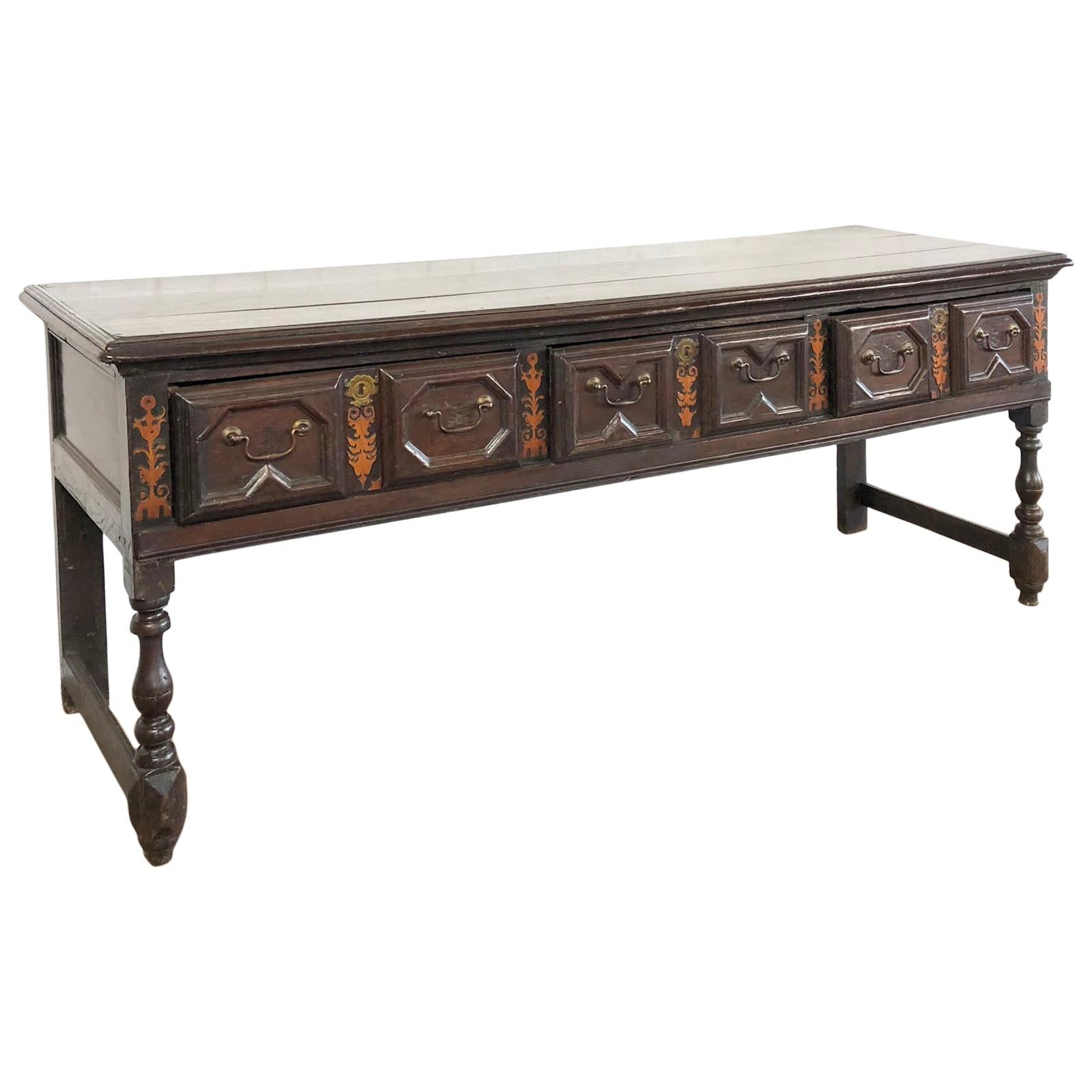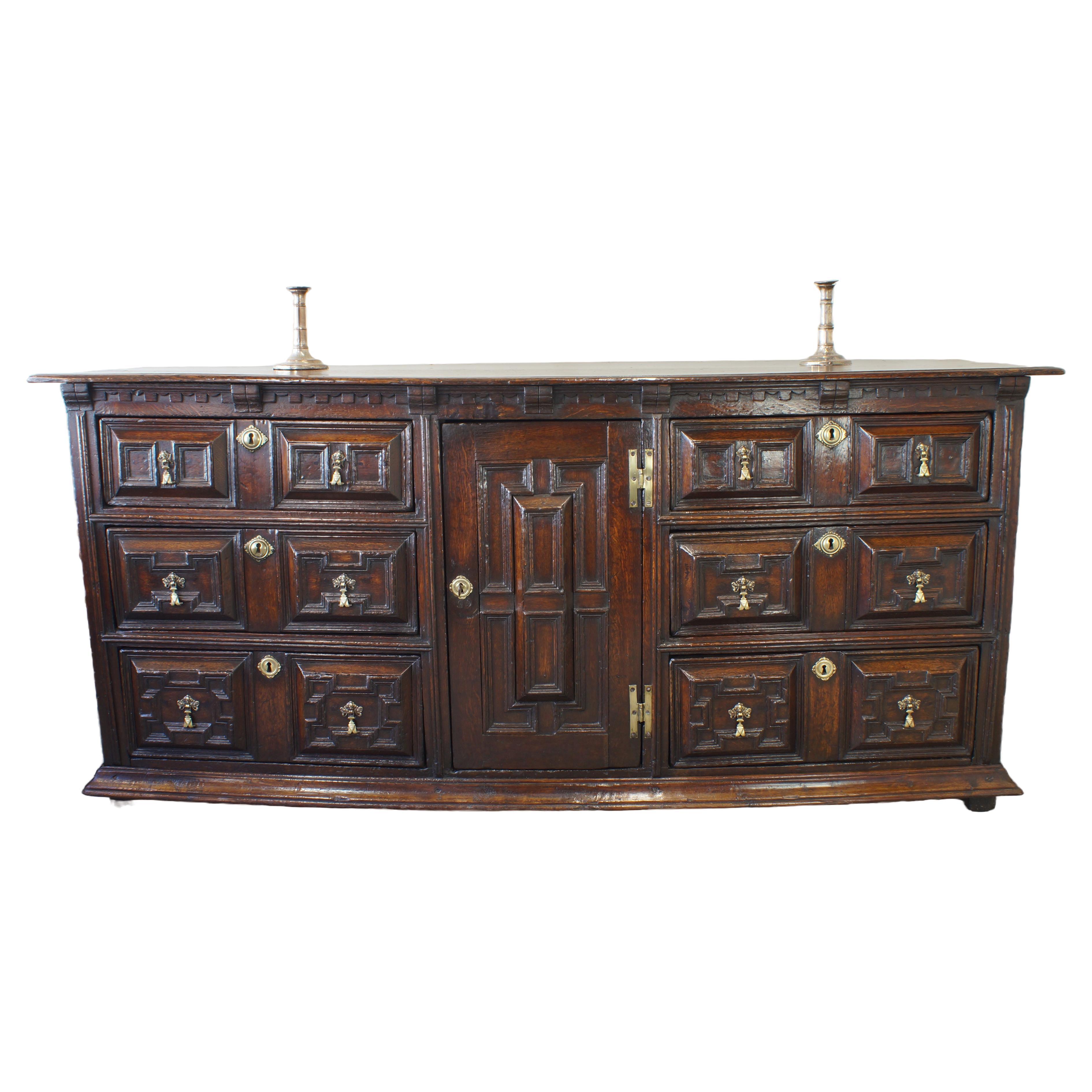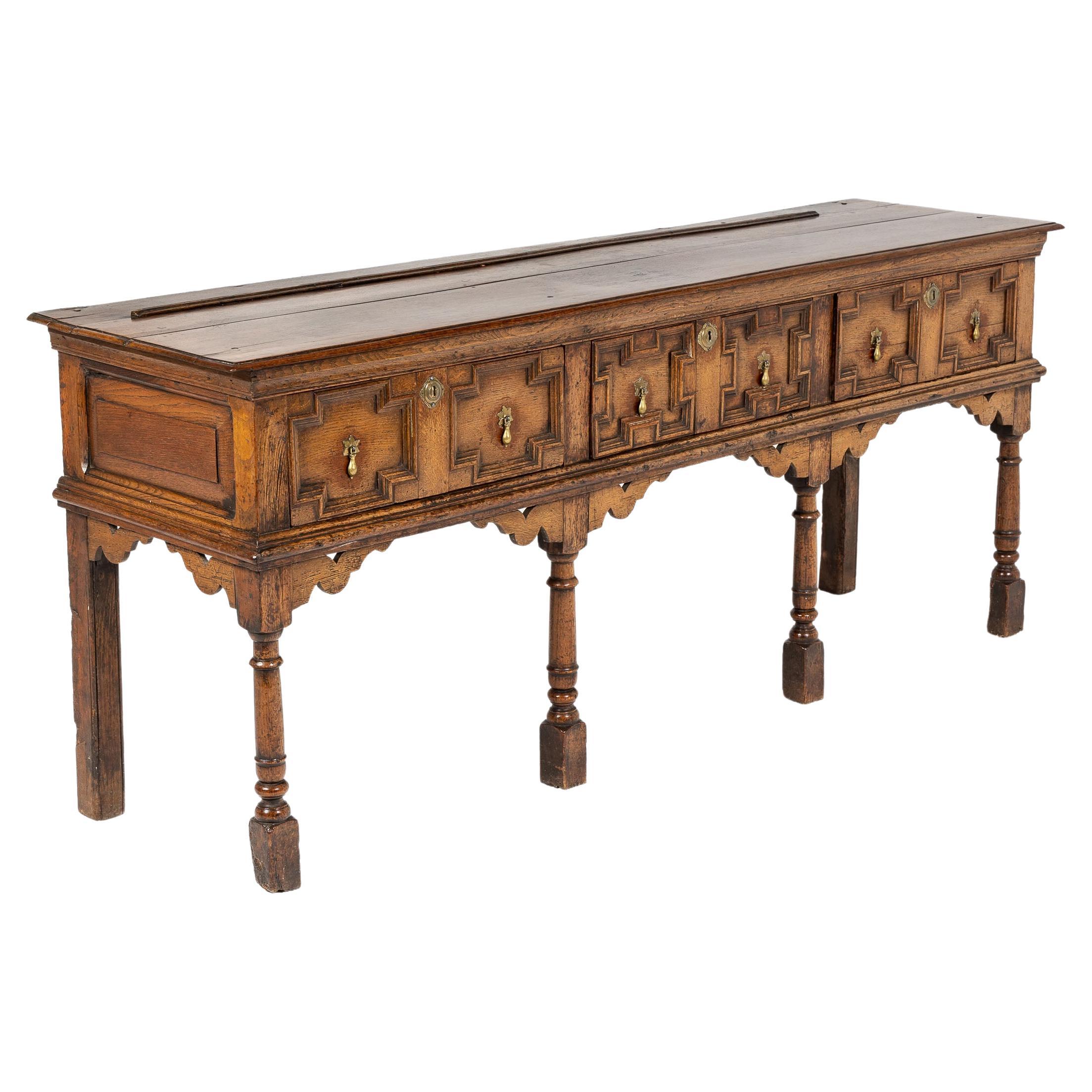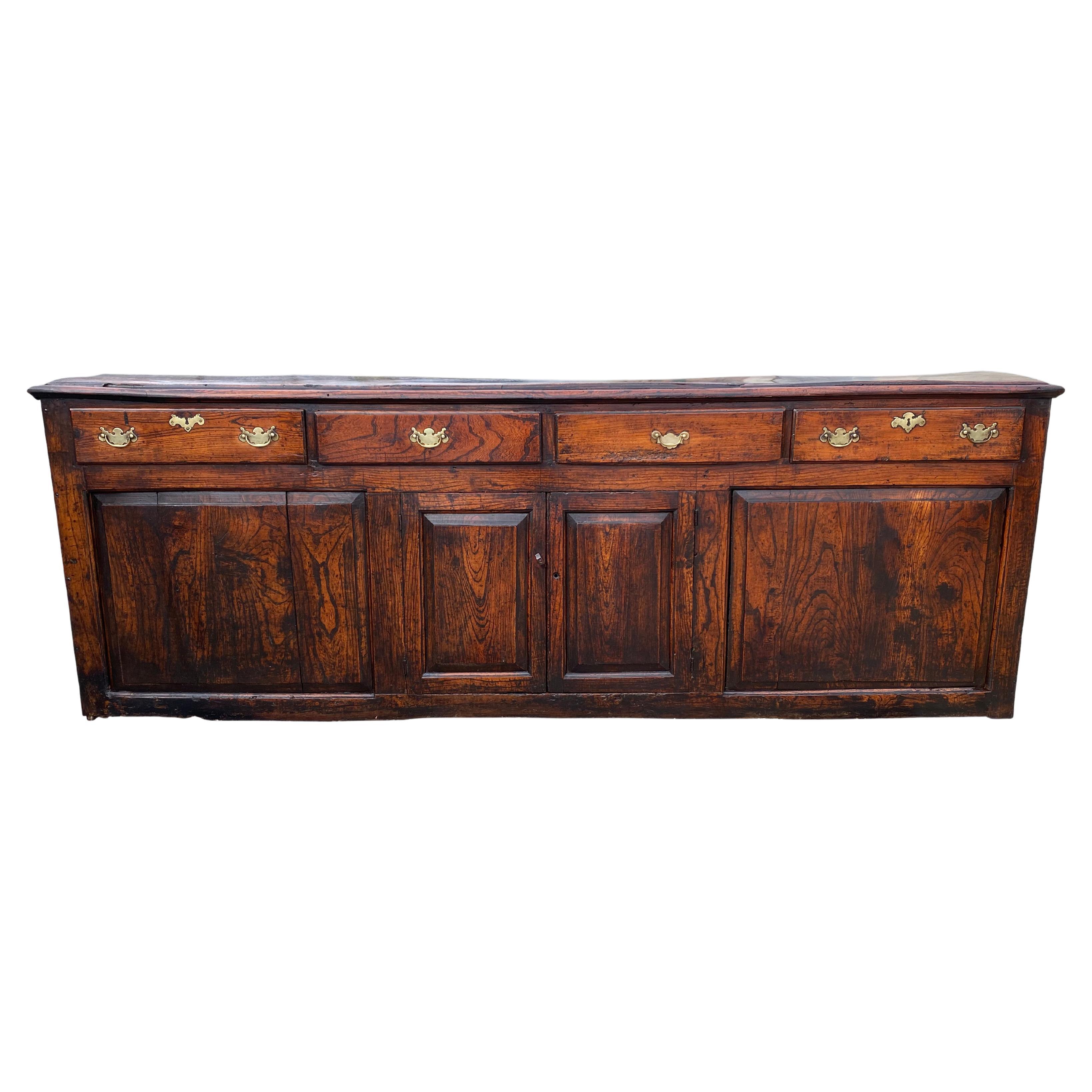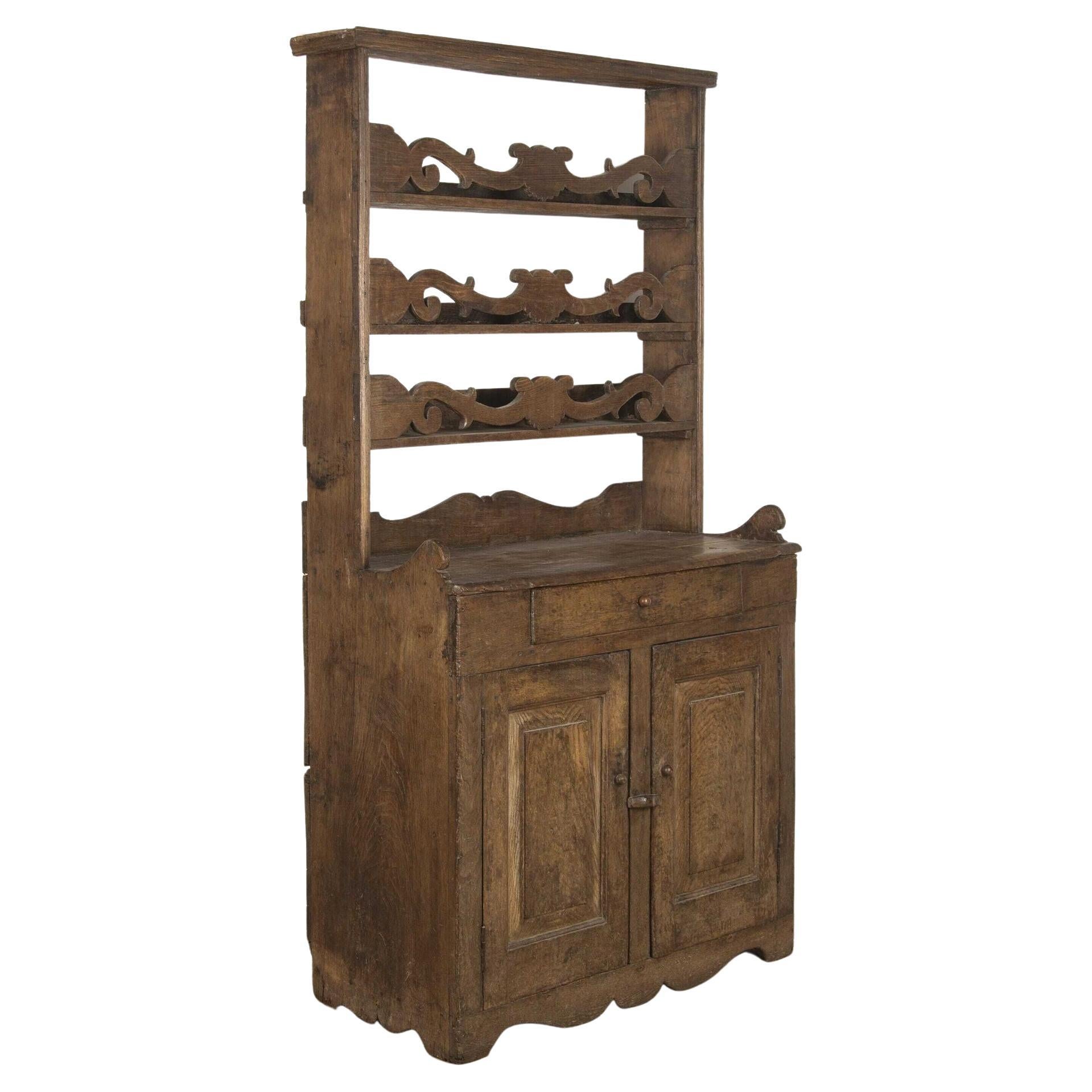Items Similar to Late 17th Century English Oak Dresser
Want more images or videos?
Request additional images or videos from the seller
1 of 15
Late 17th Century English Oak Dresser
About the Item
The Charles II period design incorporated a French influence. Furniture was often characterized by elegant carvings with a focus on reliability and usefulness. This dresser has been carved entirely from oak. Oak is a desirable hardwood that is dense and durable and an excellent choice for furniture. The fronts of the drawers have a subdued veneer trim.
This tall dresser is split into two sections. The upper section consists of a set of three drawers with a simple molding on top. The lower section is slightly wider than the upper and the drawers gradually expand in size.
The fronts of the drawers have a subdued veneer trim. Each drawer has two beautifully pressed brass bail handles and a brass lock plate. The brass creates a lovely addition to the rich brown oak.
The body sits on top of four superbly carved cabriole legs with triffid feet. This dresser incorporates long lines that contrast with the curves of the legs, bottom, and brass detailing. It has been masterfully crafted and is a shining example of the Charles II style. Overall, it would look stunning in an office, bedroom, or library. The height combined with the look of sheer masculinity, make it an antique of a lifetime.
H=69 in. W=45 in. D=25 in. 120 lbs.
- Dimensions:Height: 69 in (175.26 cm)Width: 45 in (114.3 cm)Depth: 25 in (63.5 cm)
- Style:Charles II (Of the Period)
- Materials and Techniques:
- Place of Origin:
- Period:
- Date of Manufacture:1680-1700
- Condition:Additions or alterations made to the original: The brass pulls are not original. Drawer guides have been replaced. Repaired: Almost 350 years old, there are scratches, nicks, dents, cracks, and wear throughout. Side panels have slight separation from shrinkage. All but two drawers have had the bottom cracks adhered with linen strips. Freshley waxed. Wear consistent with age and use. There are spots on the veneer trim, around the drawers, that are missing or have been reglued. The locks don't work or have a key. The top and bottom come apart for easier maneuverability. H=69 in. W=45 in. D=25 in. 120 lbs.
- Seller Location:Chicago, IL
- Reference Number:1stDibs: LU7185238562812
About the Seller
5.0
Vetted Seller
These experienced sellers undergo a comprehensive evaluation by our team of in-house experts.
Established in 1964
1stDibs seller since 2022
6 sales on 1stDibs
Typical response time: 1 hour
- ShippingRetrieving quote...Ships From: Chicago, IL
- Return PolicyA return for this item may be initiated within 14 days of delivery.
More From This SellerView All
- 17th Century Charles II English Cupboard CabinetLocated in Chicago, ILThis is a circa 1660 Charles II English cupboard. This style was characterized by elaborate carvings and large frames. During Charles II's reign, there was a revival in the art and d...Category
Antique 17th Century English Charles II Cupboards
MaterialsOak
- Late 19th Century French Renissance Revival Hand Carved Walnut Floor LampLocated in Chicago, ILThe top and bottom of the stained glass shade are embroidered with an anthemion frieze trim. The turned center post terminates with a base having scrolling garlands of foliage onto ...Category
Antique Late 19th Century French Renaissance Revival Floor Lamps
MaterialsStained Glass, Walnut
- Early 19th Century English Regency Greek Revival Gilt Carving of a SphinxLocated in Chicago, ILFrom the 1700s through the early 1800s, European aristocrats developed a fascination with ancient Egyptian culture and design that culminated in a full Egyptian Revival. Prominent figures such as Marie Antoinette and Napoleon Bonaparte commissioned rooms decorated with Egyptian motifs. This cultural moment reflects a fascination with a sophisticated civilization of great artists and pharaohs. The Regency era possessed very little knowledge of the Great Pyramids or hieroglyphics, a quality that lent Egyptian art interpretation a compelling air of mystique. This English Regency period gilt carving depicts a popular figure of borrowed Egyptian motif: the Sphinx. Recognized among educated circles as a symbol of brilliance in the ancient past, the Sphinx was well-known as a mythological creature who destroys those who failed to answer her riddle. Such a piece as this, excellent in detail and craftsmanship, may have once graced the mantle of a gentleman’s study or been exchanged as a gift between British scholars. The beautiful gold surface has been achieved by an artful combination of gilt and gesso; the art enthusiast will appreciate the intricate texture realized in the carving’s hair and tail as well as the delicate detailing of the saddle. Borrowing from the Egyptians, the Greeks had their own interpretation of the Sphinx. Greek mythology chronicled the Sphinx as being the daughter of Orthous and Chimera or Laius and attributed the riddles, which she proposed, as having been taught to her by the Muses. Crowned with a Grecian diadem and having a refined expression, she evokes an ancient yet reserved intellect. For the modern-day enthusiast of classical Greek art...Category
Antique Early 19th Century English Regency Figurative Sculptures
MaterialsGold Leaf
- 18th Century English George III Period Mahogany Armchair with Modern FabricLocated in Chicago, ILThis is a finely carved 1760 English George III armchair. The George III period was named after the English monarch of the time. It was popular among the elite and mercantile class of people, due to its excellent material and intricate carvings. Due to the multiple King Georges, each George developed its own look. The George III period is also referred to as the Chippendale style. This period was often characterized by drawing on both the Rococo and Gothic styles. Pieces sported curves, arches, Chinese influences, and cabriole legs. This chair has been entirely carved out of mahogany; a premiere wood choice known for its durability, longevity, and rich coloring. The back has an elegant splat, a principal element of eighteenth-century English chairs. Splats are the center support for a chair’s open back and originated from the importation of Chinese Ming Dynasty chairs...Category
Antique 1760s English George III Armchairs
MaterialsMahogany
- Early 19th Century English Regency Mahogany Tub Chair ArmchairBy George SmithLocated in Chicago, ILarly 19th Century English Regency mahogany armchair in the Manner of George Smith (Born in 1786). George Smith was a celebrated furniture designer during the Regency Period. His desi...Category
Antique Early 19th Century English Regency Armchairs
MaterialsMahogany
- Early 19th Century Austrian Hiking StaffLocated in Chicago, ILThis one-of-a-kind Austrian hiking staff has been handcrafted from solid oak. Oak is a relatively lightweight yet sturdy material, which lends itself perf...Category
Antique Early 19th Century Austrian Folk Art Sculptures and Carvings
MaterialsSilver, Brass
You May Also Like
- English 17th Century Charles II Oak low DresserLocated in Troy, NYEnglish oak 17th century open base long dresser, with a three-board top surrounded by a molded edge, above a frieze, containing three drawers, the drawer fronts with applied geometri...Category
Antique 1670s English Charles II Dressers
MaterialsBrass
- Late 17th Century English Oak Geometrically Moulded Dresser BaseLocated in Skipton, GBA superb 17th century oak serving dresser having a tremendous presence. The two planked top above a central cupboard door, flanking the cupboard are two banks of cushion and geometri...Category
Antique Late 17th Century English William and Mary Dressers
MaterialsOak
- 17th Century English Oak Dresser BaseLocated in Gloucestershire, GB17th century English oak dresser base with a moulded edge, plank top and three deep drawers below with excellent moulded panels as geometric decoration, brass pull handles and escutc...Category
Antique 17th Century Dressers
MaterialsOak
- 17th Century Long Oak Dresser BaseLocated in Petworth,West Sussex, GBA stunning late 17th century narrow solid oak farmhouse dresser base. Rectangular moulded planked top above 4 drawers with brass handles, above ...Category
Antique 17th Century British Country Dressers
MaterialsOak
- 17th Century Italian Chestnut DresserLocated in Gloucestershire, GBStunning 17th century florentine chestnut dresser. Dating from the 17th Century, this imposing Italian baroque dresser in chestnut has a super...Category
Antique 17th Century Italian Baroque Dressers
MaterialsChestnut
- 17th Century Carved Oak Court Cupboard, Livery CupboardLocated in Chillerton, Isle of Wight17th century carved Oak Court cupboard, Livery cupboard This Old and roomy cupboard is made in solid Oak and needless to say it is very heavy, lucki...Category
Antique Mid-17th Century Charles II Dressers
MaterialsOak
Recently Viewed
View AllMore Ways To Browse
Antique Curved Front Dresser
Taller Dresser
Durham Dresser
Decor Dresser
Mcm Colour Storage
1930s Adams Style Dresser
1960s Pink Modern Bedroom Dresser
6 Drawer Dresser 56 Inch
6 Drawer Vintage Bassett Dresser
9 Drawer Dresser Milo Baughman
American Of Martinsville Black Lacquer Dresser
Antique Eastlake Marble Top Dresser
Baker Neoclassical Dresser
Baronet Dresser
Bassett 6 Drawer Dresser
Bassett Mid Century 6 Drawer Dresser
Bodart Dresser
Broyhill Brasilia Gentlemans Chest
